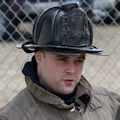Too often in the fire service, specialty teams are thought of independently. However, there arguably is no stronger connection between two disciplines than there is between confined space rescue and hazmat. Despite this link, many fire departments and rescue teams either downplay or simply don’t realize the interdependence that exists between these two disciplines and how vital joint training is to personnel safety and to the completion of successful operations.
Some of the valuable services that hazmat teams can provide to their corresponding technical rescue team include atmospheric monitoring, PPE selection, decontamination and force multiplication.
Atmospheric monitoring
The importance of monitoring air quality is well known to anyone who trained in confined space rescue. However, it often is thought of as little more than “checking a box” on an entry permit before entering a space. Although many firefighters and rescuers feel confident with the basics of using a four-gas meter, or combustible gas meter (CGM), the importance of alarm levels, short-term exposure limits (STEL) and correction factors and the intricacies of metering techniques often are overlooked by non-hazmat personnel. This is perhaps the single most valuable and important aspect of including hazmat technicians in a confined space response plan.
Atmospheric monitoring of confined spaces serves two primary purposes. First, it allows rescuers to remotely identify any atmospheric hazards that might be present in the space—and might have contributed to the incident—before they enter and to ensure that proper PPE and respiratory protection is selected. Second, it allows both the rescuers and the attendant to continually monitor the atmospheric conditions that are inside of the confined space.
The primary atmospheric hazards to be monitored in all permit-required confined spaces are oxygen, flammable (or lower explosive limit, or LEL) gases, and toxic gases (most commonly, hydrogen sulfide and carbon monoxide). Given the circumstances of the particular incident, flammable dust also might need to be monitored.
Additionally, hazmat teams have the capability to monitor for specific hazards that might not appear on a traditional four-gas meter. Through the use of specific sensors, colorimetric tubes and other technologies, hazmat teams can help to paint a full picture of the chemical hazards that are present inside of a confined space and drive decision-making on ventilation, PPE selection and decontamination requirements.
Three important points to remember are that personnel must account for the response time of their specific meter (how long that it takes for a sensor to detect a given chemical); the draw rate (how long that it takes for a pumped meter to draw a sample through a given length of tubing to reach the meter’s sensor); and the fact that atmospheric monitoring must be conducted at all levels of a space for the purpose of accounting for heavier-than-air and lighter-than-air gases.
Depending on the configuration of the confined space that’s to be entered, its location (in a building, etc.) and ventilation requirements, more four-gas meters than are readily available to the technical rescue team might be needed. Some agencies require a minimum of five calibrated four-gas meters on all confined space incidents, to allow for continuous monitoring of the area that’s around the entrance to the space; the area that’s inside of the space near the opening (think: bottom of a sewer access; the area where the entry team is operating; the area where the backup team, if activated, is operating); and the area that’s near the exhaust opening (or as a spare).
If your agency doesn’t have enough meters to fulfill the monitoring requirements of a confined space rescue, how do you obtain them? Although mutual aid might seem like an obvious choice, there’s no guarantee that the personnel who will arrive with the meter are trained in either confined space rescue or hazmat. Assuming that the meters are calibrated properly and are in good working order, this results in more equipment to be operated by the same number of people who originally were available. By establishing a relationship with your local hazmat team prior to an incident, technical rescue teams can help to ensure that they receive the type and quantity of meters that are required; that meters are calibrated and cared for properly; and that personnel who arrive can take on the responsibility of air monitoring, to free up rescue technicians for attendant, entry and backup positions.
Tracking meter readings and advising the rescue group supervisor on how to respond to alarms is a perfect job for hazmat technicians. To further simplify the integration between these disciplines, many hazmat teams have the capability to remotely monitor atmospheric readings through the use of telemetry.






